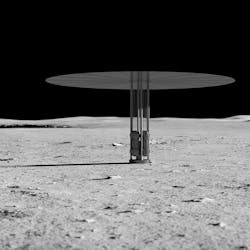One Small Step: NASA, DOE detail $5M contracts for developing Nuclear Fission power plant on the Moon
Call it the Ultimate Microgrid. Or the Lunar Chain Reactor Fueling Station of the Future.
Maybe no catchy name yet, but the National Aeronautics and Space Administration wants to launch an exploratory nuclear fission power system for demonstration on the moon by 2030. NASA and the U.S. Department of Energy (DOE) are working together to advance space nuclear technologies and have found some worthy projects to explore that nearly final energy frontier.
The two U.S. agencies have picked three proposals for a fission surace power system what could be ready to launch by the end of this decade. Nuclear power can offer both baseload and emission-free power generation.
If successful, this technology could benefit explorations under the Artemis program, including both prospective Moon and Mars voyages.
Each of the awards are about $5 million and fund development of initial design concepts for a 40-kW fission power system. The power generation unit would be expected to last at least 10 years in the lunar environment, according to NASA.
"New technology drives our exploration of the Moon, Mars, and beyond," said Jim Reuter, associate administrator for NASA's Space Technology Mission Directorate. "Developing these early designs will help us lay the groundwork for powering our long-term human presence on other worlds."
The Idaho National Laboratory, which works on numerous next-gen nuclear concepts, will support the awarded 12-month contracts. Battelle Energy Alliance, which manages operations for the INL, led the proposal request development.
The 12-month contracts include Lockheed Martin, which will partner with BWXT and Creare on its project; Westinghouse partnering with Aerojet Rocketdyne; and IX, a joint venture of Intuitive Machines and advanced reactor startup X-Energy. The latter will partner with Maxar and Boeing.
Nuclear fission reaction is considered smaller and lightweight relative to other power system options, according to NASA. They also could provide continuous power and pave the way for long-duration missions.
“The Fission Surface Power project is a very achievable first step toward the United States establishing nuclear power on the Moon,” said Idaho National Laboratory Director John Wagner. “I look forward to seeing what each of these teams will accomplish.”
The Phase 1 awards will provide NASA critical information from industry that can lead to a joint development of a full flight-certified fission power system. Fission surface power technologies also will help NASA mature nuclear propulsion systems that rely on reactors to generate power, NASA says. These systems could be used for deep space exploration missions.
NASA’s fission surface power project is managed by the agency’s Glenn Research Center in Cleveland. The power system development is funded by the Space Technology Mission Directorate’s Technology Demonstration Missions program, which is located at Marshall Space Flight Center in Huntsville, Alabama.
Nuclear fission is the chain reaction powering U.S. nuclear reactor plants. Those 90-plus generate 20 percent of the nation’s electricity and more than half of its carbon-free power generation.
-- -- --
(Rod Walton, senior editor for EnergyTech, is a 14-year veteran of covering the energy industry both as a newspaper and trade journalist. He can be reached at [email protected]).
About the Author
Rod Walton, EnergyTech Managing Editor
Managing Editor
For EnergyTech editorial inquiries, please contact Managing Editor Rod Walton at [email protected].
Rod Walton has spent 17 years covering the energy industry as a newspaper and trade journalist. He formerly was energy writer and business editor at the Tulsa World. Later, he spent six years covering the electricity power sector for Pennwell and Clarion Events. He joined Endeavor and EnergyTech in November 2021.
Walton earned his Bachelors degree in journalism from the University of Oklahoma. His career stops include the Moore American, Bartlesville Examiner-Enterprise, Wagoner Tribune and Tulsa World.
EnergyTech is focused on the mission critical and large-scale energy users and their sustainability and resiliency goals. These include the commercial and industrial sectors, as well as the military, universities, data centers and microgrids. The C&I sectors together account for close to 30 percent of greenhouse gas emissions in the U.S.
He was named Managing Editor for Microgrid Knowledge and EnergyTech starting July 1, 2023
Many large-scale energy users such as Fortune 500 companies, and mission-critical users such as military bases, universities, healthcare facilities, public safety and data centers, shifting their energy priorities to reach net-zero carbon goals within the coming decades. These include plans for renewable energy power purchase agreements, but also on-site resiliency projects such as microgrids, combined heat and power, rooftop solar, energy storage, digitalization and building efficiency upgrades.

